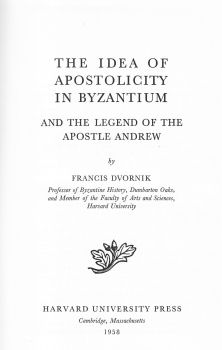Contents
Foreword
I. The Guiding Principle in the Evolution of Church Organization
The practice of the Apostles — The Council of Nicaea sanctions
the adaptation of the ecclesiastical organization to the administrative division
of the Empire — The bishop of Alexandria as supra-metropolitan? —
Position of Antioch — The rights of the bishops of Antioch compared with those
of Rome and Alexandria — Ephesus, Caesarea, Heraclea as supra-metropolitan
cities? — The canons of the Council of Constantinople (381) compared with the
Nicene decrees — The see of Jerusalem — Jerome's testimony — Adaptation to the
divisions of the Empire in the West: Rome, Italy, Illyricum — Africa and Spain —
Gaul and Arles
II. The Idea of Apostolicity in the West and in the East before
the Council of Chalcedon
Rome the only apostolic see in the West — Apostolic sees in the
East — Canon three of the Council of Constantinople (381) viewed in a new light
— Reaction in the West — The views of the Council of 382 on apostolicity — St.
Basil and the idea of apostolicity — John Chrysostom — Struggle between
Alexandria and Constantinople — The principle of apostolicity at the Council of
Ephesus — St. Cyril, Dioscorus of Alexandria, and Domnus of Antioch — Leo I's
success in stressing the apostolicity of his see in the East — The idea of
apostolicity at Chalcedon — Leo I and the so-called twenty-eighth canon —
Attitude of the legates — Omission of apostolicity in the canon — Reasons for
Leo's negative attitude — Leo's apparent success a disguised compromise
III. Growth of the Idea of Apostolicity during the Acacian Schism
Acacius and Pope Simplicius — Gelasius'
claims derived from Petrine tradition — Eastern and western reaction to Gelasius'
claims — Increasing concern with apostolicity in the East — Libellus Hormisdae —
Apostolic character of the Roman see in imperial and patriarchal letters —
Currency of the idea of apostolicity in the East and its possible consequences
for Constantinople
IV. The Birth of the Andrew Tradition Concerning Byzantium
The transfer of Andrew's relics and its meaning — No trace of the
Andrew tradition in Chrysostom's writings — St. Gregory of Nazianzus, Cyril of
Jerusalem, Theodoret and Basil of Seleucia on Andrew — Western writers on Andrew
— The Andrew Legend unknown in the sixth century — The see of Constantinople
called “apostolic" from the seventh century onward — This usage not originated
by Andrew Legend — The defenders of image-worship promote the idea of
apostolicity in Constantinople — The Narratio key to the dating of
writings containing the Andrew and Stachys Legend? — First codification of the
Andrew Legend in Pseudo-Epiphanius' List of Disciples — Origin of List of
Apostles and Disciples; dating of Pseudo-Epiphanius' List — Pseudo-Dorotheas'
List later than Pseudo-Epiphanius' List and the Narratio
V. The Legendary Elements in the Andrew Tradition
The lost apocryphal Acts of Andrew as the ultimate source of the
Constantinopolitan tradition — Gregory of Tours on Andrew's stay in Byzantium —
The apocryphal Acts of Andrew known in the East and West from the fifth to the
ninth centuries — Date of the composition of the apocryphal Acts of Andrew —
Scythia, not Achaea, as Andrew's missionary field — Did Andrew preach in Asia
Minor? — The legend of the maneaters as a reflection of the old tradition of
Andrew's preaching in Scythia — Later tradition identifying the city of the
maneaters with Sinope — The “Scythian tradition" reflected in the original Acts
and in the Legends of Andrew's preaching in Colchis and in Georgia — Legendary
traits in the “Achaean tradition" — Oldest traditions quote Luke as missionary
of Achaea — Spread of the new “Achaean tradition" — Legendary accounts of
Argyropolis and Zeuxippus — Probable origin of the “Achaean tradition" —
Conclusion
VI. The Growth of the Andrew Legend
Ninth-century writings propagating the Andrew and Stachys Legend
— The Laudatio, the Passio Artemii, and their connection with the
Andrew Legend — The Laudatio echoes some ideas of the Patriarch Photius —
Nicetas the Paphlagonian and Ignatius the Deacon on Andrew and Stachys —
Theophanes' critical attitude toward the Andrew Legend — Another source of
Byzantium's apostolic character: Constantinople heir of Ephesus and of the
Apostle John. Ignatius' and Photius' testimony — John's connection with
Constantinople in Armenian and Nestorian tradition — The Patriarch Photius and
the Andrew Legend — The Andrew tradition, one of the principal arguments in the
opuscule against Roman primacy, falsely attributed to Photius — The
ninth-century Typicon of Constantinople on Andrew, Stachys, and
Metrophanes — Spread of the Andrew and Stachys Legend in the tenth century — Its
acceptance by the Syrians and Georgians — The Andrew story in the Russian
Primary Chronicle — Pseudo-Symeon's and Cedrenus' catalogue of Byzantine
bishops
VII. The Idea of Apostolicity and the Andrew Legend in the
Controversies between Constantinople and Rome
The idea of apostolicity as the basis of the pentarchic order —
The pentarchic idea at the Ignatian Council of 869-870 — The definition of the
duties of emperors and patriarchs in the Epanagoge reflects a new spirit
created by the growth of apostolicity — Possibilities of a rapprochement on this
new basis — The argument of apostolicity in the controversies of the tenth and
eleventh centuries — The position of the see of Constantinople in Church
organization and the Western canonists of the eleventh century — Eastern writers
of the eleventh and twelfth centuries — The Andrew Legend and the controversies
during the thirteenth century — How the character of universal teachers
attributed to the apostles by Greek polemists diminished the value of the Andrew
tradition for the Greeks — The Andrew Legend in the fourteenth century in
Byzantium — The Councils of Lyons and Florence on the see of Constantinople —
Acceptance of the Andrew Legend by the Latin West
List of Abbreviations.
List of Manuscripts Quoted
Bibliography
—
Index
